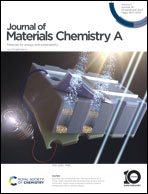Photocatalytic activity enhancement with 4-cyanophenylacetylene-modified Cu2O cubes and rhombic dodecahedra and use in arylboronic acid hydroxylation†
Abstract
Surface 4-cyanophenylacetylene (4-CNA) functionalization enabled inert Cu2O cubes to possess a high photocatalytic activity. The modified rhombic dodecahedra also exhibited large activity enhancement, but decorated octahedra showed only moderate activity improvement. Holes are more important than electrons to the photocatalytic activity of 4-CNA-modified Cu2O cubes. Electron paramagnetic resonance (EPR) data confirm the observed photocatalytic results and show that both hydroxyl and superoxide radicals are photogenerated from modified Cu2O crystals. Density functional theory (DFT) calculations reveal the emergence of a narrow 4-CNA-derived band in the Cu2O band gap to facilitate electron transfer through the molecule to the crystal exterior for radical production. Bader charge difference and planar average local potential analyses also suggest good electron migration for Cu2O cubes through 4-CNA. The functionalized cubes can photocatalyze 4-methoxyphenylboronic acid hydroxylation with a high yield of 92% utilizing the generated superoxide radicals. Conjugated molecular functionalization on semiconductor crystals is a highly effective approach to boosting charge transfer.



 Please wait while we load your content...
Please wait while we load your content...